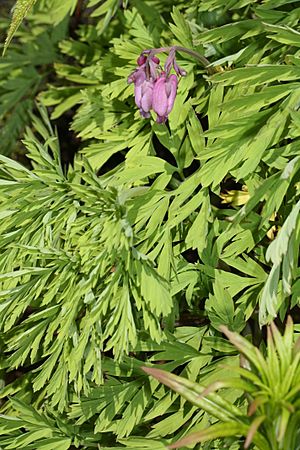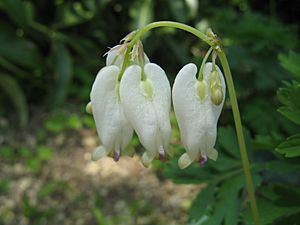Western bleeding heart facts for kids
Quick facts for kids Western bleeding heart |
|
|---|---|
 |
|
| Scientific classification | |
| Genus: |
Dicentra
|
| Species: |
formosa
|
The Dicentra formosa, also known as the western, wild, or Pacific bleeding heart, is a beautiful flowering plant. It has leaves that look like ferns and flowers that hang down. These flowers can be pink, purple, yellow, or cream. This plant grows naturally along the Pacific Coast of North America.
Contents
What is the Pacific Bleeding Heart?
The Pacific bleeding heart is a perennial plant, which means it lives for more than two years. It's also an herbaceous plant, meaning it has soft stems, not woody ones like trees. Its leaves are divided many times, making them look like a fern. They grow from a special underground stem called a rhizome at the bottom of the plant. This plant can grow up to 18 in (45 cm) tall and 24 in (60 cm) wide.
Flowers and Seeds
The flowers are shaped like hearts and can be pink, red, or white. They grow in groups of 5 to 15 on top of stems that don't have leaves. These stems rise above the fern-like leaves. The plant blooms from mid-spring until autumn, with the most flowers appearing in spring.
Each flower has four petals. The two outer petals form a small pouch at the bottom and curve outwards at the tips. The two inner petals stand straight up and connect at their tips. Behind the petals, there are two tiny, pointed parts called sepals. After the flowers, the plant makes seeds inside plump, pointed pods. These seeds can easily grow into new plants.
Plant Behavior and Safety
Sometimes, after flowering, the plant goes dormant during the summer. This means it rests and doesn't grow much. Then, it might grow and flower again in the autumn.
It's important to know that this plant contains a substance called isoquinoline. This substance is not safe for animals like cattle to eat.
Similar Plants
The Pacific bleeding heart is often mistaken for another plant called the fringed bleeding heart (Dicentra eximia). Sometimes, it's even sold under the wrong name. The fringed bleeding heart has thinner flowers and longer, more curved outer petal tips. The Dicentra formosa is also related to Lamprocapnos spectabilis, which is another popular plant also called "bleeding heart."
- Flowers and leaves
Where the Pacific Bleeding Heart Lives
The Pacific bleeding heart grows naturally in wet woodlands, forests, and along streambanks. You can find it from California all the way up to British Columbia. It grows from sea level up to high mountain areas called the subalpine zone.
Different Types of Pacific Bleeding Heart
There are two main types, or subspecies, of Dicentra formosa:
- Dicentra formosa subsp. formosa
- Dicentra formosa subsp. oregona
The subsp. formosa type grows in most of the plant's range. This includes Vancouver Island and southern British Columbia, and south through Washington and Oregon to central California. It's found in the Coast Ranges, Cascades, and on the western side of the Sierra Nevada.
The subsp. oregana type grows in a smaller area. You can find it in southern Oregon and northern California. It prefers special serpentine soils in the Siskiyou Mountains.
These two types also look a bit different:
- Dicentra formosa subsp. formosa: Its leaves are a bit pale or bluish-green underneath, but not on top. Its flowers are purple-pink, pink, or white.
- Dicentra formosa subsp. oregona (sometimes spelled oregana): Its leaves are pale or bluish-green both on top and underneath. Its flowers are cream or pale yellow.
-
Wild plants on the Iron Horse Regional Trail in the Bay Area, California
Growing Pacific Bleeding Heart in Gardens
The Dicentra formosa is a popular plant for gardens. Many different types, called cultivars, have been created. A cultivar is a plant type that people have grown for specific traits, like flower color or leaf shape. Some of these cultivars have won awards, like the Royal Horticultural Society's Award of Garden Merit (marked agm).
Popular Cultivars
Here are some examples of different cultivars:
- White and green flowers:
* 'Langtrees' (= 'Pearl Drops') – has bluish-green leaves. * 'Margaret Fish' – has bluish-gray-green leaves. * 'Quicksilver' – also has bluish-gray-green leaves, but doesn't like hot, humid weather or too much sun. * 'Snowflakes' (= 'Fusd') – has green leaves. * 'Sweetheart' – has green leaves.
- Pink and red flowers:
* 'Bacchanal' agm – has deep red flowers. * 'Coldham' – has deep burgundy flowers. * 'Luxuriant' agm – has red flowers. * 'Zestful' – has deep rose-pink flowers.
Hybrid Cultivars
There are also several hybrid cultivars. A hybrid plant is created by crossing two different types of plants. These hybrids involve D. formosa and other species like D. eximia (from eastern America) and D. peregrina (from Japan).
Some examples of hybrid cultivars include:
- 'Adrian Bloom' – has dark pink flowers and bluish-green leaves.
- 'Aurora' (a mix of D. formosa and D. eximia) – has pure white flowers and gray-green leaves. It handles hot, humid weather well.
- 'Bountiful' (a mix of D. formosa subsp. oregana and D. eximia) – has rosy red flowers and bluish-green leaves.
- 'King of Hearts' – has pink flowers and bluish-gray-green leaves.
- 'Stuart Boothman' agm – has deep pink flowers and gray-green leaves.
History of the Pacific Bleeding Heart
Europeans first learned about the Pacific bleeding heart (Dicentra formosa subsp. formosa) when a Scottish surgeon and naturalist named Archibald Menzies found it. This happened during the Vancouver Expedition in 1792. Menzies collected seeds in Nootka Sound and sent them to the Royal Botanic Gardens at Kew in England in 1795. From there, the plant started to be grown in gardens across Europe.
It seems the plant wasn't grown in the United States until 1835. That's when a nurseryman named William Kenrick started selling it in Boston. The subsp. oregana type was first grown around 1932 by a company called Borsch and Sons in Oregon. However, it's still not grown as often as the subsp. formosa type.









